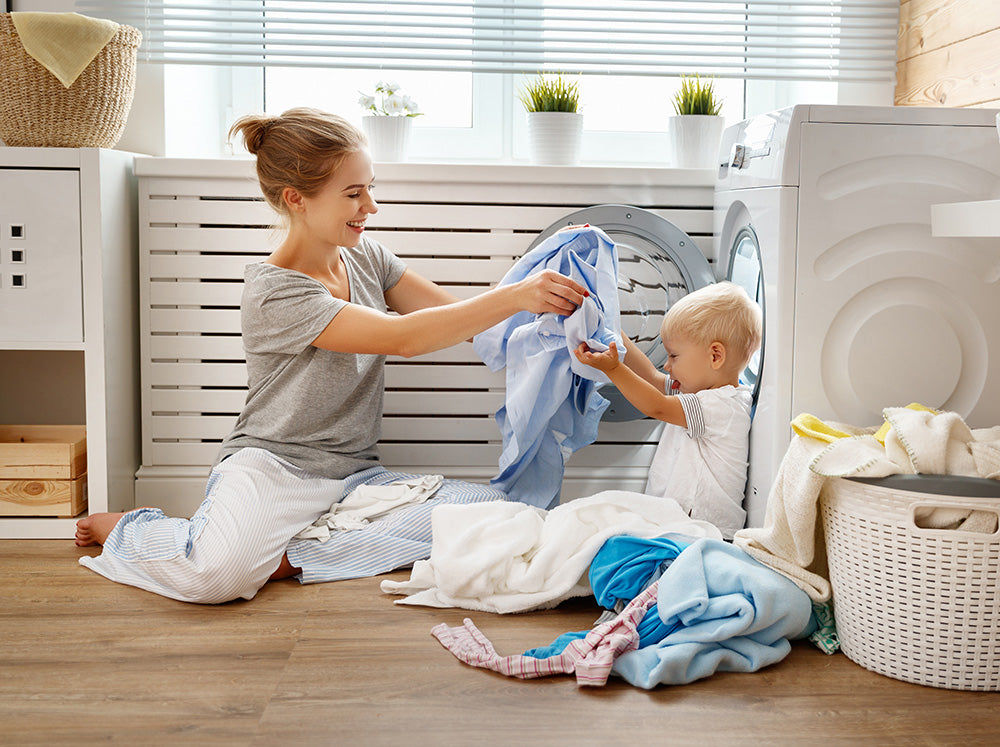
Finding Baby-Safe Cleaning Products: What You Need to Know
In our previous article, we highlighted why traditional cleaning products can be dangerous for your baby. Now that you're aware of those risks, you may be wondering: How can you find cleaning products that are genuinely safe for your family?
The best baby-safe cleaning products are those that are 100% natural, as they don’t contain harmful chemicals that could irritate, poison, or otherwise harm your child. However, not all 'green' cleaners are as natural as they claim to be.
To avoid the risks of conventional cleaning products, many parents turn to non-toxic alternatives. However, with so many products labeled 'natural' or 'biodegradable,' it can be tough to know which are genuinely safe. Unfortunately, these labels are often unregulated, and companies may use misleading marketing tactics - known as 'greenwashing’ - to make products seem more eco-friendly than they really are. To ensure safety, always check the ingredient list yourself.
The Truth About Ingredient Lists
In Canada and the U.S., cleaning product manufacturers aren’t required to disclose ingredients. Some list nothing at all, leaving you guessing. A good rule of thumb: If a company has nothing to hide, it should list its ingredients.
Even when ingredients are listed, labels can be misleading. Brands may provide only partial details or use vague terms like “plant-based surfactant,” revealing little about what’s actually inside. Artificial additives like mineral oil or petroleum by-products could still be lurking.
Many so-called “natural” products still contain synthetics and toxins. For example, a label might say “fragrances from natural oil blends,” but it could include both synthetic fragrances and essential oils—not helpful if you're avoiding fragrance due to health risks.
Manufacturers also extend shelf life by mixing ingredients with artificial preservatives. Even if you check for preservatives like MI or MCI, they might still be present through hidden additives.
The bottom line? Don’t trust labels—look deeper.

How to Choose Non-Toxic Cleaning Products for Babies
One way to ensure a product is truly eco-friendly is by looking for trusted green certificates, which help verify its environmental and health impact.
But not all are equal. In North America, Safer Choice, Green Seal, and EcoLogo are the most common eco-certifications for cleaning products. However, each certification has its own standards - and some have significant shortcomings.
For example, Safer Choice allows ingredients like sodium lauryl sulfate (SLS), which is contaminated with carcinogens like 1,4-dioxane. SLS is considered "best in class," despite being toxic, even though there are safer, natural alternatives. While manufacturers must disclose ingredients to the EPA, they don’t have to list them on the label, leaving consumers unaware of potential hazards.

Ecocert: The Superior Green Certification
This is why we recommend Ecocert — an internationally recognized certification that guarantees a product is genuinely eco-friendly. Ecocert verifies every claim, ensuring products labeled “100% natural” are exactly that.
Ecocert ensures all ingredients are eco-friendly, non-toxic, and sustainably sourced. Manufacturers can only use approved suppliers who meet strict quality and sustainability standards.
Beyond ingredients, Ecocert evaluates manufacturing processes to ensure they align with environmental best practices.
Most importantly, Ecocert requires full ingredient transparency - both on product labels and websites. Terms like “plant-based surfactant” or “natural fragrance” aren’t allowed. Instead, ingredients must follow INCI (International Nomenclature of Cosmetic Ingredients) for clear identification.

Ingredients to Avoid
Even with ingredient lists, identifying harmful chemicals can be tricky. To make things easier, here are some common chemicals to watch out for:
-
Artificial Fragrances
Often contain: Phthalates, parabens, and other chemicals
- Phthalates – Carcinogenic; linked to birth defects, respiratory issues, chemical burns, and hormone disruption
- Parabens – Associated with cancer, developmental disorders, and skin irritation
-
Synthetic Preservatives
Examples: Methylisothiazolinone (MI), Methylchloroisothiazolinone (MCI), Benzisothiazolinone (BI), Octylisothiazolinone (OIT)
- Strong allergens and irritants
- Can trigger severe allergic reactions
-
Triclosan
Usage: Disinfectant and preservative
- Carcinogenic; suspected to cause birth defects and developmental disorders
- Can cause skin irritation
-
Dyes & Colorants
- May contain petrochemicals and toxic substances
- Can cause cancer, skin irritation, and respiratory issues
- Harmful to the environment
-
Harsh Surfactants & Foaming Agents
Examples: Alcohol ethoxylates (Laureth-7), Sodium Lauryl Sulfate (SLS), Sodium Laureth Sulfate (SLES)
- Found in laundry detergents and dish soaps
- May be contaminated with carcinogens like ethylene oxide and 1,4-dioxane
-
Ethanolamine Compounds
Examples: Monoethanolamine (MEA), Diethanolamine (DEA), Triethanolamine (TEA)
- Cheap surfactants that irritate the skin
- Can react with other ingredients to form cancer-causing chemicals
-
Glycol Ethers
Examples: 2-Methoxyethanol, 2-Ethoxyethanol, 2-Butoxyethanol
- Used as solvents in many cleaning products
- Can cause headaches, nausea, lung damage, kidney/liver toxicity, and long-term anemia
-
Chlorine & Chlorine Bleach
- Common in many household cleaners
- Toxic when swallowed; inhaling chlorine gas can severely irritate airways, eyes, and skin
- Reacts with ammonia to form highly toxic chloramines
-
Ammonia & Ammonia Compounds
- Found in glass cleaners and some dish soaps
- Can cause severe burns and irritation
- Reacts with chlorine to form toxic chloramines
-
Formaldehyde
- Still present in some laundry detergents and dish soaps
- Carcinogenic; can cause severe burns, toxicity if inhaled, and skin irritation

Finding Baby-Safe Cleaning Products
When choosing cleaning products for your baby, research is essential. Understanding green certifications and ingredient lists ensures you're selecting truly non-toxic, baby-safe options.
Learn more about EWG, a valuable tool for identifying toxin-free cleaning products.
In the meantime, explore AspenClean’s all-natural, hypoallergenic products, designed to keep your home safe for babies and families. Our unscented laundry detergents, dishwasher pods, and oxygen bleach offer powerful cleaning without toxins, while our lightly scented options, like eucalyptus or lavender laundry pods, use only organic essential oils. Safe for your baby, safe for the planet.